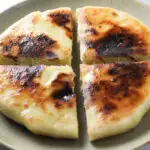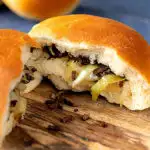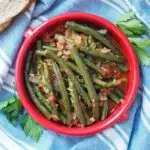Komiška pogača is a classic Croatian bread from the island of Vis that is filled with a herbed tomato sauce and anchovies. This dish boasts classic Mediterranean flavors!
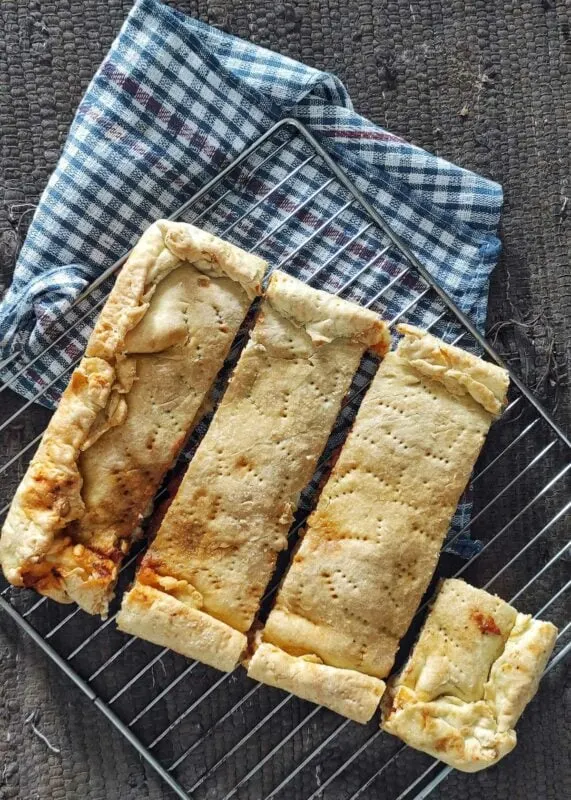
Croatian islands hide many wonders – from breathtaking views and nature to beautiful culture, tradition, and architecture.
Some islands are so isolated that you can almost feel ancient spirits wandering through those old-classic Dalmatian houses and cobbled streets. The air is filled with peace or in Croatian – fjaka.
Those islands hide more than one secret, and they have amazing, traditional, and authentic cuisine.
The Croatian island of Vis
One of the most beautiful islands with untouched nature is the island of Vis.
Vis is known for its stunning beauties, amazing hospitality, peaceful life, and – incredible traditional cuisine.
Due to that, we are going to talk about a delicious dish from the small town of Komiža called komiška pogača.
But before getting into all the details, it is important to know that the island of Vis has 2 similar recipes for this dish.
The town of Vis is on the northeast side of the island and there, people prepare viška pogača. On the other side of the island, where you find the town of Komiža, the people prepare komiška pogača.
It is important not to mix those two recipes since there is a bit of difference in the ingredients, but we will get into all those details a bit later, so you know the story behind those two recipes with intertwined history.

Gastronomic history of the island Vis
The Greeks the first town on this island, Vis.
Greeks brought their own culture, gastronomy, and traditions, which then inspired the inhabitants of the island to create something new – new traditions and new recipes.
One of the new pieces of history and gastronomy was the recipe for pogača.
The Greek influence led the inhabitants of the island to play more with different ingredients and seasonings. As a result, they started to make pogača with onion, salted fish, and oil. In some culinary variations they added parsley, wild marjoram, cheese, olives, and fresh tomatoes.
Those were the first recipes for the island’s famous pogača.
Throughout history, inhabitants of the island were using simple ingredients to make delicious dishes enriched with flavors and aromas. Even though all the recipes and dishes may be simple and quite easy to do, they truly present an amazing gastronomy tradition of the island.
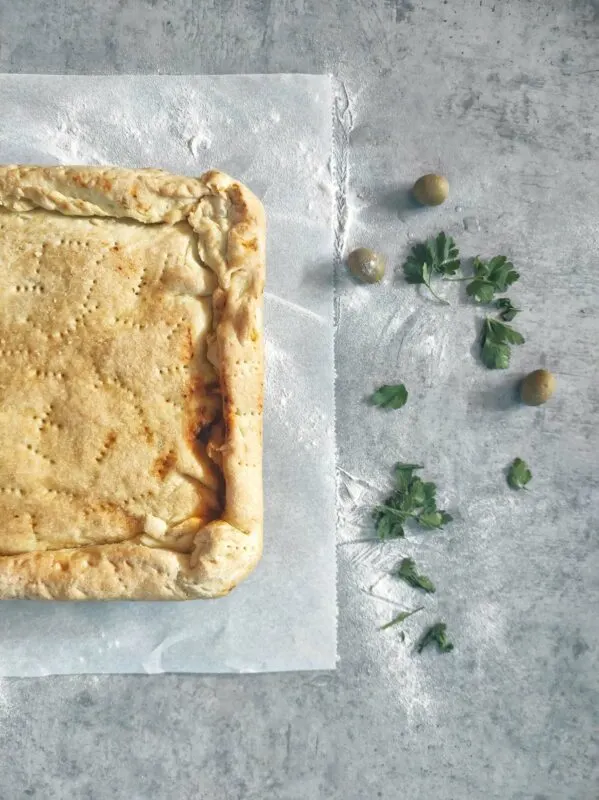
Two variations on this Croatian bread
Komiška pogača (ko-mi-scha po-ga-cha) is an old classic dish that beautifully presents those typical ingredients of the island and the Mediterranean.
The recipe for this Croatian bread is quite simple and easy. The main ingredients are homemade dough, salted anchovies, tomato juice, onions, and olive oil.
All those ingredients beautifully combine during baking, so all the flavors and aromas truly present the most beautiful nuances of the Mediterranean.
Now, since we have already mentioned viška pogača, the only difference between those two recipes is the usage of tomatoes. Each recipe is delicious in its own way. And once you taste both, it is really hard to decide which one is better.
But why decide, let us just enjoy all the flavors!
Komiška pogača is an aromatic dish that is made with simple, everyday, and accessible ingredients. Ingredients which were quite important in the past. Since the island is really isolated, people needed to find simple recipes with the ingredients they already had or could get a hold of, such as fish.
In those days, komiška pogača was just komiška during the summer because only in those couple of months, people had fresh tomatoes. For the rest of the year, people prepared classic viška pogača.
But the moment canned tomatoes came to be, komiška pogača, along with viška pogača, became a trademark of the island!
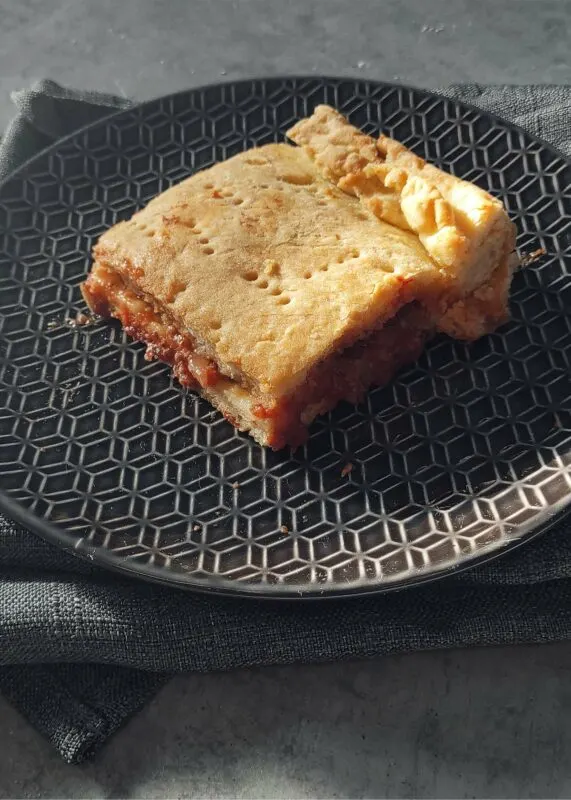
What to know and how to prepare the Croatian bread pogača
Komiška pogača is really easy to make and prepare. It does not require a long list of ingredients, nor a lot of time to make, knead and bake.
And in case you do not have tomato juice, you can always omit it and make viška pogača! It is great to have that alternative version, because hey, anyone can forget to buy tomato juice!
The most important thing while making this Croatian bread is the dough.
Once you get that nice and firm ball, it is important to cover it with the cloth and let it rest for an hour or two. I know waiting is not everyone’s favorite while trying to make some delicious dish, but it is definitely worth it!
After that, divide the dough into 2 balls. Then roll each out thinly, around 5 millimeters (slightly over 1/8 of an inch).
Also, make sure to remove the bones from the anchovies before you use them in the dish.
Okay, these are all the pointers before making the dish, now let’s go into kneading, filling, and baking!
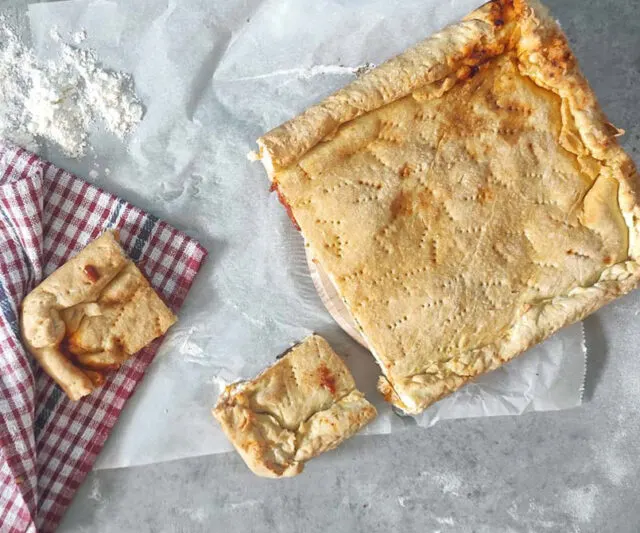
Komiška Pogača (Croatian Filled Bread)
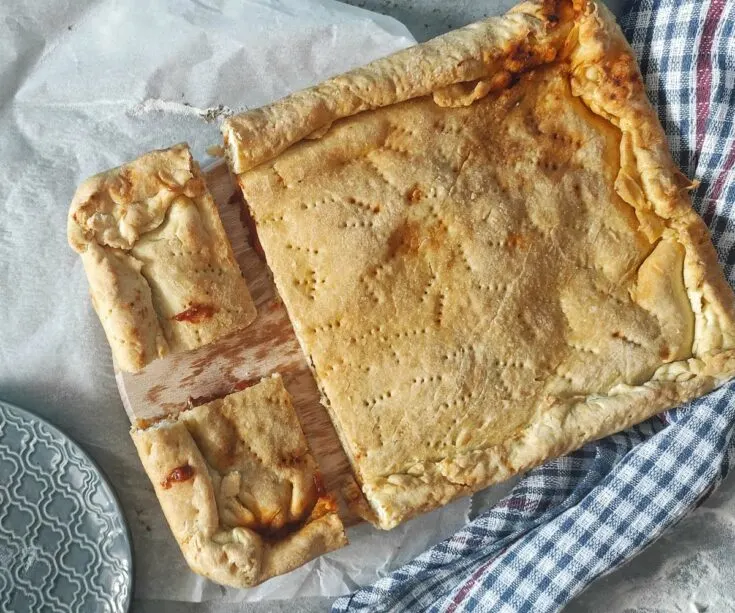
Komiška pogača is a classic Croatian bread from the island of Vis that is filled with a herbed tomato sauce and anchovies. This dish boasts classic Mediterranean flavors!
Ingredients
For the dough
- 2.20 lb (7 3/4 c) bread flour
- 13.52 oz (1 2/3 c) warm water
- 14 g (5 tsp) active dry yeast
- 17 g (1 Tbsp) salt
- olive oil
For the filling
- olive oil
- 2.4 oz salted anchovies
- 1 onion
- 13.52 oz (1 2/3 c) tomato juice
- salt and pepper (to taste)
Putting it together
- 5 olives, chopped into small pieces
- 2 tsp oregano
- olive oil
- fresh parsley
- pepper
Instructions
For the dough
- Put flour, water, yeast, and salt into a large bowl. Mix all the ingredients until combined.
- Add a good drizzle of olive oil to the mixture and mix everything.
- Keep mixing and then kneading until you get a firm dough. (Alternately, this can be done in a stand mixer with a dough hook.)
- Turn the dough out onto a floured counter and knead for a couple of more minutes, until very smooth.
- Cover the dough with a cloth and let it rest for at least an hour.
For the filling
- Clean the anchovies (remove any bones) and dice the onions.
- Add a little olive oil to a skillet and heat over medium.
- Sauté the onion in the olive oil for a couple of minutes and then add the tomato juice* and a pinch of salt and pepper (to taste).
- Let everything cook for around 10 minutes.
Putting everything together
- Grease a high sided, 33x23cm baking dish (9x13 inches).
- Divide the rested dough into 2 balls, one slightly bigger and the other slightly smaller.
- Roll out the bigger dough thinly (about 5 mm (slightly over 1/8")) and fit it in the prepared baking dish, letting any extra hang over the sides.
- Put the prepared tomato sauce with onions on the dough.
- Place the anchovies and olive pieces over the sauce.
- Drizzle some olive oil over top of the filling. Then, sprinkle the oregano and some fresh parsley and pepper.
- Roll out the smaller dough thinly as well (about 5 mm (slightly over 1/8")) and place it over the filling.
- Pull the edges of the bottom dough up over the sides of the top dough and press well on the edges to seal the filling inside.
- Prick the top dough with a fork and let everything rest for around 15 minutes.
- Preheat your oven to 200C (392F).
- Brush the top dough with more olive oil.
- Bake the pogača for 35 minutes, until golden.
- Once it is baked, remove it from the oven and cover it with cloth for 15 minutes.
- Then, cut it into squares and serve with with red wine.
Notes
*If making viška pogača you would simply omit the tomato juice in this step.
Nutrition Information:
Yield:
5Serving Size:
1/5 of recipeAmount Per Serving: Calories: 672Total Fat: 10g
If you liked this recipe, here are some similar dishes you may enjoy!

Ana has a bachelor’s degree in journalism, and she has received a Rector’s award for achievements during her studies. She is an experienced writer for restaurants and wineries, and she loves to cook, research, and experiment with different cuisines and ingredients. Besides writing, Ana loves to photograph and travel, especially to Korčula, Croatia which is her second home and the best inspiration for new recipes and flavors.
